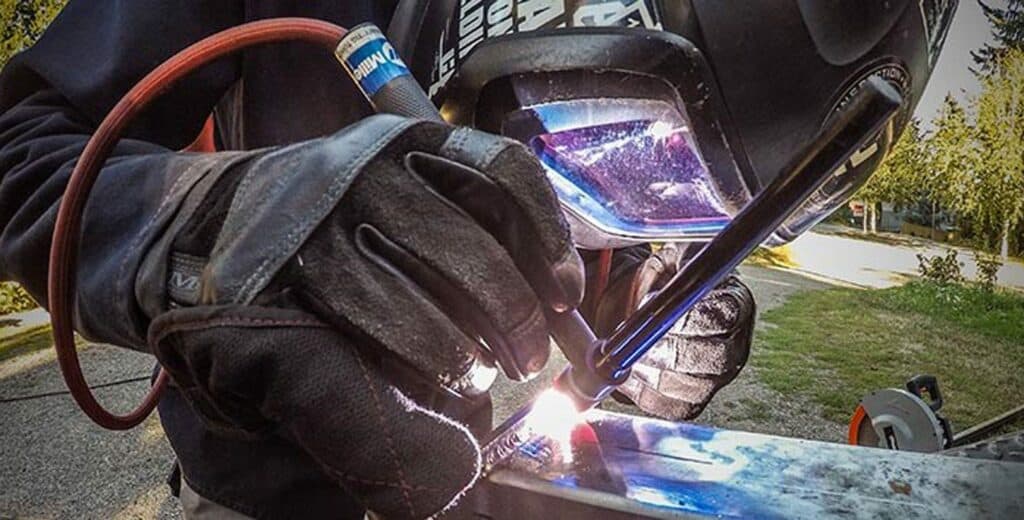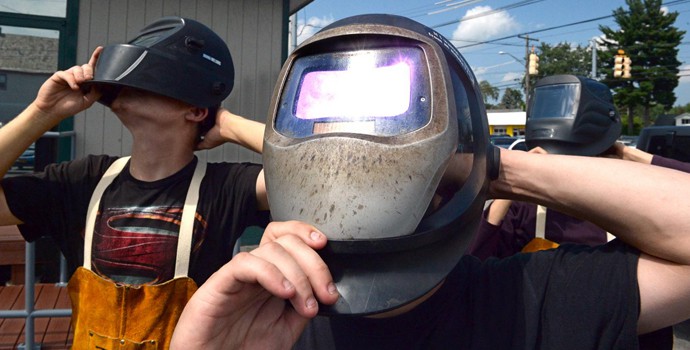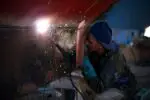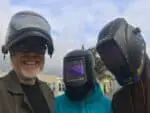There are basically two kinds of solar welding helmets: solar welding helmets with replaceable batteries and solar welding helmets with fixed batteries.
How long the helmet lasts will entirely depend upon the type that you’ve purchased. If your solar welding helmet has replaceable batteries, it can last up to a decade when taken care of.
In the case of solar welding helmets with fixed batteries, the life isn’t as long as expected. In fact, most manufacturers nowadays produce solar welding helmets with replaceable batteries only.
Here’s another interesting piece of info that you should be aware of: a solar welding helmet has photovoltaic cells alongside lithium-ion batteries.
The photovoltaic cells use solar energy to charge the helmet. The lithium-ion batteries (or AAA batteries, if that’s what’s used in your helmet) can be charged by the sun as well as the rays emitted by the welding arc while you’re working.
And the best thing is that these batteries (AAA as well as lithium-ion) can also store the energy so that your helmet is always charged.
A solar welding helmet can last for 7 to 10 years because it has two options to remain working efficiently: the power sourced from the Sun and the power sourced from the batteries (harnessed as well as stored).
If you’ve been meaning to purchase a solar welding helmet too, then we’d like to interest you in this guide that’ll take you through some fascinating facts like how to test a welding helmet, how to maintain it so that it lasts for 7 years, and more.
Dive in for all the details.
How do you test a solar welding helmet?
A solar welding helmet can last for 7 to 10 years and protect you from the dangerous rays and fumes emitted by the electrical arc. However, for that purpose, it’s essential that your helmet is properly working.
Sometimes, an exhausted battery can compromise the efficacy of the helmet without your knowledge. Hence, it is very important that you test your solar welding helmet from time to time so that you know when to replace the battery (if possible at all).
There are three ways in which you can test whether or not your auto-darkening welding helmet is in perfect working condition. Have a look!
#1. The solar test
The reason that a solar welding helmet is even called auto-darkening is that the lens automatically gets dark as soon as it’s exposed to light and brightness.
So, when the sun is at its brightest and hottest, take the helmet outside. Face the sunlight and look at how the lens reacts. It should immediately turn dark.
Ideally, the reaction time of the lens should be less than 1/25000th of a second. Obviously, you can’t count this figure. Since it’s so quick, you shouldn’t feel the glare as soon as you step out in the sun.
If even for a flick of a second, you feel the need to squint your eyes, it’s a clear indication that the lens or the battery of your helmet is not working properly.
Bear in mind, it takes not even 5 seconds to get a welder’s flash when the arc is struck. So, if your helmet somehow malfunctions even slightly, it won’t be able to protect you, let alone last!
See also: Best Solar Welding Lens
#2. The lighter test
It’s almost similar to the solar test, only, it’s less dramatic. Take out a cigarette lighter and put the flame in close proximity in front of the helmet.
It should immediately turn dark. Any lag means either the helmet is somehow discharged or the lens is not functioning properly.
Another reason could be that the grind mode might be on. So, if your helmet has the grind mode feature, make sure to turn it off before conducting the test.
#3. The TV (IR signal) test
An auto-darkening helmet is very sensitive to infrared rays. You can use your television as the source of infrared rays for the purpose of safely testing your helmet.
The minute you turn on the TV and start pressing buttons on your remote, the helmet should instantly detect and sense the presence of IR rays and turn dark.
Sometimes, you might see welders testing their solar helmets during welding itself. However, it’s a risky move. As we said, it takes less than 5 seconds to get an arc eye (welder’s flash). So, the ultimate choice will always be yours.
The bottom line here is that testing the solar welding helmet frequently will keep your eyes safe.
Do solar welding helmets need charging?
Solar welding helmets have photovoltaic cells that automatically harness the energy from the sun.
Besides, even the UV rays from the electrical arc charge the helmet while you’re still welding. On top of all this, the batteries store the power.
So, if by charging you mean charging using a traditional power source (electricity), then no. A solar welding helmet does not require an electrical socket to get charged.
The sun and the rays emitted during welding are the sources that these helmets use to stay charged.
See also: Do Welding Helmets Protect From UV?
How do you store a welding helmet – 4 ways to make your solar helmet last
High-quality solar welding helmets with replaceable batteries have a long, long life.
Yet, even though they have both photovoltaic cells and batteries that store energy, there are times when the batteries can really exhaust and the power might die completely.
Wondering why? Well, the most common reason is improper storage.
You have to store your solar welding helmet with utmost care so that it can last for at least 7 years, as promised.
Here are the 4 ways to make sure the helmet doesn’t stop working.
1.) Don’t store a solar power helmet in freezing or damp conditions. It will affect the quality and efficiency of photovoltaic cells as well as the batteries.
2.) Don’t keep the helmet unused for a long time. The battery life drops drastically when the batteries remain unused for a long time.
So, either keep your helmet in a bright sunny spot frequently or weld regularly while wearing the helmet. These are the only two ways that the batteries won’t be sitting idle.
3.) Don’t throw the helmet on the ground when you reach home after a long tiring day. Yes, a solar welding helmet is robust, but continual manhandling will affect it badly.
4.) Another thing you need to stop doing is keeping the helmet in the trunk of your truck (vehicle) without securing it.
If it’s loose, it will keep bumping around during the entire duration you’re driving. That’s even worse than throwing it on the ground.
Only when it’s cared for and stored properly that a solar welding helmet will last for 7 to 10 years before you need to absolutely replace it and buy a new one.
FAQs
Are solar welding helmets good?
Indeed, they are. Not only do they auto charge in the Sun or while you’re welding, but they also save energy and do not require a traditional source of power for charging.
Hence, they turn out to be very economical and environmentally friendly. Besides, using a solar welding helmet will reduce your carbon footprint that’s again very essential to protect the environment.
How long do batteries last in welding helmets?
Ideally, even non-replaceable (fixed) batteries that can be charged using solar power or rays emitted from the welding arc should last for 7 years in a solar welding helmet.
That, however, can happen in theory. The chances that a battery will last that long in the absence of a traditional power source are rare.
That’s the reason that solar welding helmets with replaceable batteries are a better purchase. With proper storage, you won’t have to purchase a new helmet for almost a decade.
If the battery malfunctions, you’ll have the option to easily replace those batteries instead of having to replace the helmet.
Do auto-darkening welding helmets have batteries?
Yes. Solar-powered welding helmets have batteries in addition to photovoltaic cells. However, the batteries can be fixed or replaceable.
Should my welding helmet darken when I look at the sun?
Yes, as long as your welding helmet is a solar welding helmet, it should. The entire concept behind a solar-powered welding helmet is that its lens reacts to the Sun and gets dark immediately in the presence of light.
Do auto-darkening welding helmets fail?
Yes, absolutely, they do. As we already mentioned, an auto-darkening helmet should be tested from time to time. The chances that a new helmet will fail are very less. But, there are two scenarios that can fail a solar welding helmet:
1.) If it is not stored properly and the batteries stay idle for a long time, it will fail.
2.) If the batteries are fixed, then the chances that the auto-darkening helmet will have to be replaced with a new one are higher because you won’t have the option to replace the batteries.
Concluding Thoughts:
Solar welding helmets can last for about 7-10 years with proper care. They have batteries installed in addition to photovoltaic cells and those batteries have two purposes: one, to store energy harnessed from the Sun, and two) to get charged from the rays emitted by the welding arc.
However, the variations of the helmets can make the choice trickier. You might find yourself confused about whether you should buy a solar helmet with fixed batteries or a solar welding helmet with replaceable batteries.
Most welders, in general, prefer buying solar welding helmets that have replaceable batteries. These helmets last for up to a decade since the batteries can be replaced if, for any reason, they go bad.
Another advantage is that, if you feel that the helmet is heavy, you can remove the batteries after charging the helmet under the Sun and use it. But, you won’t have this option either when the batteries are fixed.
However, the final decision will always be yours.
The last thing we’d like to mention as a parting note is that ASTM-approved and ANSI-approved welding helmets aren’t cheap. Hence, investing in buying something that has more chances of failing is a risky little move.
Keeping this in mind, most experienced welders, for the sake of more flexibility and options, prefer buying solar welding helmets with replaceable batteries.








